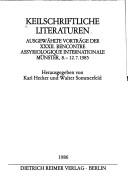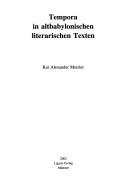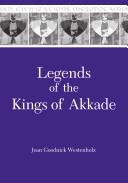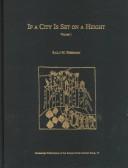| Listing 1 - 10 of 22 | << page >> |
Sort by
|
Book
ISBN: 9781589837539 9781589837546 9781589837751 1589837541 1589837533 1589837754 1299998828 Year: 2013 Volume: 29
Abstract | Keywords | Export | Availability | Bookmark
 Loading...
Loading...Choose an application
- Reference Manager
- EndNote
- RefWorks (Direct export to RefWorks)
Book
ISBN: 9781107052055 9781107280328 9781107678309 9781108514712 1108514715 110705205X 110728032X 1108505775 1107678307 Year: 2017 Publisher: Cambridge ; New York : Cambridge University Press,
Abstract | Keywords | Export | Availability | Bookmark
 Loading...
Loading...Choose an application
- Reference Manager
- EndNote
- RefWorks (Direct export to RefWorks)
"Women's Writing of Ancient Mesopotamia presents fresh and engaging translations of works that were composed or edited by female scribes and elite women of the ancient Near East. These texts provide insight into the social status, struggles, and achievements of women during the earliest periods of recorded human history (c.2300-540 BCE). In three introductory chapters and a concluding chapter, Charles Halton and Saana Svärd provide an overview of the civilization of ancient Mesopotamia and examine gender by analyzing these different kinds of texts. The translations cover a range of genres, including hymns, poems, prayers, letters, inscriptions, and oracles. Each text is accompanied by a short introduction that situates the composition within its ancient environment and explores what it reveals about the lives of women within the ancient world. This anthology will serve as an essential reference book for scholars and students of ancient history, gender studies, and world literature"-- "These texts provide insight into the social status, struggles, and achievements of women during the earliest periods of recorded human history (ca. 2300 - 540 BCE). In three introductory chapters and a concluding chapter, Charles Halton and Saana Svard provide an overview of the civilization of ancient Mesopotamia and examine gender by analyzing these different kinds of texts. The translations cover a range of genres, including hymns, poems, prayers, letters, inscriptions, and oracles"--
LITERARY CRITICISM / African. --- Assyro-Babylonian literature --- Civilization, Ancient. --- HISTORY / Ancient / General. --- Women authors. --- Iraq --- Civilization --- Ancient civilization --- Akkadian literature --- Babylonian literature

ISBN: 3496008792 9783496008798 Year: 1986 Volume: Bd. 6 Publisher: Berlin: Reimer,
Abstract | Keywords | Export | Availability | Bookmark
 Loading...
Loading...Choose an application
- Reference Manager
- EndNote
- RefWorks (Direct export to RefWorks)
Akkadian literature --- Middle Eastern literature --- Littérature moyen-orientale --- History and criticism --- Congresses --- Histoire et critique --- Congrès --- Assyro-Babylonian literature --- Congresses. --- -Assyro-Babylonian literature --- -Akkadian literature --- Babylonian literature --- Near Eastern literature --- -Congresses --- -History and criticism --- Littérature moyen-orientale --- Congrès --- History and criticism&delete& --- Assyro-Babylonian literature - History and criticism - Congresses --- Middle Eastern literature - History and criticism - Congresses
Book
ISBN: 0802053157 9780802053152 Year: 1975 Volume: 3 Publisher: Toronto: University of Toronto press,
Abstract | Keywords | Export | Availability | Bookmark
 Loading...
Loading...Choose an application
- Reference Manager
- EndNote
- RefWorks (Direct export to RefWorks)
Assyro-Babylonian literature --- Akkadian language --- History and criticism --- Texts --- 892.12 --- -Assyro-Babylonian literature --- -Akkadian literature --- Babylonian literature --- Accadian language --- Assyrian language --- Assyro-Babylonian language --- Babylonian language --- Semitic languages --- Assyrische literatuur --- Assyro-Babylonian literature. --- Texts. --- History and criticism. --- -Assyrische literatuur --- 892.12 Assyrische literatuur --- Akkadian literature --- Assyro-Babylonian literature - History and criticism --- Akkadian language - Texts
Book
ISBN: 0962001341 096200135X Year: 1993 Publisher: BETHESDA : CDL Press,
Abstract | Keywords | Export | Availability | Bookmark
 Loading...
Loading...Choose an application
- Reference Manager
- EndNote
- RefWorks (Direct export to RefWorks)
892.1 --- Akkadian literature --- -Akkadian literature --- Babylonian literature --- Akkadische, Sumerische literatuur --- Translations into English --- Akkadian language --- Assyro-Babylonian literature --- Chronology, Assyro-Babylonian. --- Names, Akkadian. --- Names, Sumerian. --- Sumerian language --- Translations into English. --- -Akkadische, Sumerische literatuur --- 892.1 Akkadische, Sumerische literatuur --- -892.1 Akkadische, Sumerische literatuur
Book
ISBN: 1501504983 9781501504969 1501504967 9781501504976 1501504975 9781501504983 9781501513855 1501513850 Year: 2017 Publisher: Boston ; Berlin : De Gruyter,
Abstract | Keywords | Export | Availability | Bookmark
 Loading...
Loading...Choose an application
- Reference Manager
- EndNote
- RefWorks (Direct export to RefWorks)
Scholars often assume that the nature of Mesopotamian kingship was such that questioning royal authority was impossible. This volume challenges that general assumption, by presenting an analysis of the motivations,methods, and motifs behind a scholarly discourse about kingship that arose in the final stages of the last Mesopotamian empires. The focus of the volume is the proliferation of a literature that problematizes authority in the Neo-Assyrian period, when texts first begin to specifically explore various modalities for critique of royalty. This development is symptomatic of a larger discourse about the limits of power that emerges after the repatriation of Marduk's statue to Babylon during the reign of Nebuchadnezzar I in the 12th century BCE. From this point onwards, public attitudes toward Marduk provide a framework for the definition of proper royal behavior, and become a point of contention between Assyria and Babylonia. It is in this historical and political context that several important Akkadian compositions are placed. The texts are analyzed from a new perspective that sheds light on their original milieux and intended functions.
Assyro-Babylonian literature. --- Marduk (Babylonian deity) --- Akkadian literature. --- Akkadische Literatur. --- Ashurbanipal. --- Assurbanipal. --- Marduk. --- Sanherib. --- Sennacherib. --- Gods, Assyro-Babylonian --- Akkadian literature --- Babylonian literature --- Iraq --- Assyria --- Irak --- Rāfidayn, Bilād --- Bilād al-Rāfidayn --- Republic of Iraq --- Jumhuriyah al Iraqiyah --- History --- Kings and rulers. --- Assyro-Babylonian literature --- Kings and rulers in literature. --- History and criticism.

ISBN: 3934628036 Year: 2002 Volume: 279 Publisher: Münster : Ugarit-Verlag,
Abstract | Keywords | Export | Availability | Bookmark
 Loading...
Loading...Choose an application
- Reference Manager
- EndNote
- RefWorks (Direct export to RefWorks)
Akkadian philology --- Akkadian language --- Philologie akkadienne --- Akkadien (Langue) --- Texts --- Textes --- -Assyro-Babylonian literature --- -Akkadian literature --- Babylonian literature --- Accadian language --- Assyrian language --- Assyro-Babylonian language --- Babylonian language --- Semitic languages --- Tense --- History and criticism --- -Tense --- Assyro-Babylonian literature

ISBN: 0931464854 1575063115 1575065037 Year: 1997 Volume: 7 Publisher: Winona Lake, IN : Eisenbrauns,
Abstract | Keywords | Export | Availability | Bookmark
 Loading...
Loading...Choose an application
- Reference Manager
- EndNote
- RefWorks (Direct export to RefWorks)
The most impressive legacy of the Dynasty of Akkade (ca. 2310-2160 B.C.E.) was the widespread, popular legends of its kings. Dr. Westenholz offers an annotated edition of all the known legends of the Akkadian kings, with transliteration, translation, and commentary. Of particular interest to biblical scholars is the inclusion of “The Birth Legend of Sargon,” which is often compared to Moses in Exodus.
Assyro-Babylonian literature. --- Legends --- Assyro-Babylonian literature --- -Akkadian literature --- Babylonian literature --- Folk tales --- Traditions --- Urban legends --- Folklore --- Babylonia --- -Kings and rulers --- Littérature assyro-babylonienne --- Babylone --- Kings and rulers --- Rois et souverains --- Akkadian literature --- Vavilonii︠a︡ --- Bavel --- Bābil --- Babylonien --- Sumer --- Kings and rulers. --- Legends. --- Middle East --- Czars (Kings and rulers) --- Kings and rulers, Primitive --- Monarchs --- Royalty --- Rulers --- Sovereigns --- Tsars --- Tzars --- Heads of state --- Queens --- Orient --- Asia, South West --- Asia, Southwest --- Asia, West --- Asia, Western --- East (Middle East) --- Eastern Mediterranean --- Fertile Crescent --- Levant --- Mediterranean Region, Eastern --- Mideast --- Near East --- Northern Tier (Middle East) --- South West Asia --- Southwest Asia --- West Asia --- Western Asia --- Vavilonii͡
Book
ISBN: 9789004245679 9789004245686 9004245685 9781299476387 1299476384 9004245677 Year: 2013 Volume: 9 Publisher: Leiden Boston Brill
Abstract | Keywords | Export | Availability | Bookmark
 Loading...
Loading...Choose an application
- Reference Manager
- EndNote
- RefWorks (Direct export to RefWorks)
In Bodies of Knowledge in Ancient Mesopotamia Matthew Rutz explores the relationship between ancient collections of texts, commonly deemed libraries and archives, and the modern interpretation of titles like ‘diviner’. By looking at cuneiform tablets as artifacts with archaeological contexts, this work probes the modern analytical categories used to study ancient diviners and investigates the transmission of Babylonian/Assyrian scholarship in Syria. During the Late Bronze Age diviners acted as high-ranking scribes and cultic functionaries in Emar, a town on the Syrian Euphrates (ca. 1375-1175 BCE). This book’s centerpiece is an extensive analytical catalogue of the excavated tablet collection of one family of diviners. Over seventy-five fragments are identified for the first time, along with many proposed joins between fragments.
Divination --- Omens --- Assyro-Babylonian religion. --- Assyro-Babylonian literature. --- Cuneiform tablets --- History --- BODY, MIND & SPIRIT / Divination / Fortune Telling --- BODY, MIND & SPIRIT / Divination / General --- BODY, MIND & SPIRIT / Prophecy --- Portents --- Prodigies (Omens) --- Signs (Omens) --- Superstition --- Signs and symbols --- Augury --- Soothsaying --- Occultism --- Worship --- Tablets, Cuneiform --- Clay tablets --- Cuneiform writing --- Religion, Assyro-Babylonian --- Religions --- Akkadian literature --- Babylonian literature

ISBN: 0924171669 0977914518 9780977914517 9780924171666 9781575067681 9781575067698 1575067692 1575067684 Year: 2017 Volume: 17 Publisher: Winona Lake, Indiana: Eisenbrauns,
Abstract | Keywords | Export | Availability | Bookmark
 Loading...
Loading...Choose an application
- Reference Manager
- EndNote
- RefWorks (Direct export to RefWorks)
This volume continues the publication of the important Mesopotamian omen collection Shumma Alu, with text editions of Tablets 41 through 63. After the omen texts dealing with the examination of entrails of sacrifical animals and the omens dealing with astrological phenomena, this collection ranks as next in importance. This book thus constitutes the presentation of a primary edition of an important portion of ancient Mesopotamian religious and social literature.‹/p›The first two volumes of this publication appeared in 1998 and 2006 and are still in print and available from Eisenbrauns.
Akkadian language --- Omens --- Akkadien (Langue) --- Présages --- Texts --- Textes --- Omens. --- Portents --- Prodigies (Omens) --- Signs (Omens) --- Superstition --- Signs and symbols --- Assyro-Babylonian literature. --- Akkadian language. --- Assyro-Babylonian literature --- Akkadian literature --- Babylonian literature --- Accadian language --- Assyrian language --- Assyro-Babylonian language --- Babylonian language --- Semitic languages --- Akkadian language - Texts
| Listing 1 - 10 of 22 | << page >> |
Sort by
|

 Search
Search Feedback
Feedback About UniCat
About UniCat  Help
Help News
News